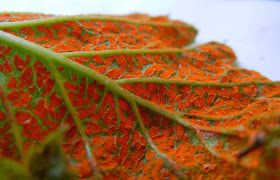
Tragedy has struck! Mind you, it's an uncommonly beautiful tragedy: a parasitic rust has attacked every one of our black raspberry patches. The colour of this fungus, unlike any iron rust I've ever seen, is a fluorescent 1969-blacklight-poster orange, a don't-hit-this-on-a-dark-road-in-the-middle-of-the-night orange, a ridiculously blinding, especially-when-placed-against-new-green-raspberry-leaf orange. So pretty! So deadly!
 |
| Black raspberry rust on underside of leaf. |
Arthuriomyces peckianus
The rust on my black raspberries is Arthuriomyces peckianus, which is extremely similar to Gymnoconia nitens, a species that prefers blackberries. Both are autoecious, meaning they require only a single host to complete their life cycle. Most other rusts are heteroecious, alternating between two completely unrelated hosts. Some of these dual-host species have such a complicated reproduction strategy that they produce what I think is a plethora of spore types, covering all the bases with not just one or two, but up to five different kinds of spores (for more info go here).
 |
| Arthuriomyces peckianus aeciospores |
Puccinia coronata
Members of the genus Puccinia for instance, some of which are pathogens of cereal grains, all produce five spore types. The one my friend Tony and I found growing on buckthorn leaves while collecting for Ontario's 2014 Bioblitz, Puccinia coronata, causes oat and barley crown rust. First found in North America in Nebraska in 1992, here it is in Toronto less than twenty-five years later. Its affect on oat and barley yields is not yet known. But look how pretty it is!
 |
| Puccinia coronata forms tiny erupting bumps on the underside of buckthorn leaves. |
 |
| Buckthorn rust aeciospores |
Cronartium ribicola
 |
| Cronartium ribicola attacks five-needle pines. |
Gymnosporangium juniperi-virginianae
Infected apple trees can suffer major defoliation that can increase winter damage, affect fruit size and quality, and deform apples. Apple growers are sometimes advised to destroy all cedar trees growing within a mile of their orchards, which is perhaps an unrealistic way to deal with the problem. Of course, the other way to stop infection is to spray with fungicides. Or eat gnarly apples, which, incidentally, make another great wine.
.jpg) |
| The jelly-like telia of cedar-apple rust appear in the spring on eastern red cedar. |
The Honeybee Connection
But here's where rusts get really cool. For more than a century, people have been observing honeybees collecting spore "pollen" from various species of rusts. This happens often enough that rust spores are regularly found in hives as well as in the guts of honeybees (I have to say I was thrilled to hear that beekeepers inspect their bees' gut contents!). So what's going on?
First off, many individual rust spores are similar in size to the pollens bees collect, so it's easy for them to pack them into their pollen baskets. Honeybees are more likely to collect rust spores when there is a dearth of pollen. Rust spores aren't high in protein, but there may be enough to supplement the bees' diet when pollen sources are low. Though some spore-collecting bee colonies seem fine, others show clear signs of decline. Is this a sign that the spores are toxic, or does it simply point to poor nutrition in the hives? More study is obviously needed.
The dispersal of spores by honeybees and other insects is certainly advantageous for rust fungi and they have clearly evolved to tap into this transport system. Their day-glo orange colours, high in yellows, are very visible to honeybees and other insects. Some rusts also produce a sweet pycnidial secretion, mimicking flower nectar, while others go so far as to produce floral scents. Some rusts use all three of these strategies.
So, basically, the orange spots or blisters produced by many rusts are "pseudoflowers," and their purpose, using colour, and sometimes sugar and scent, is to attract insects to help carry their spores closer to their alternate hosts, or, in the case of the Arthuriomyces peckianus on my black raspberries that has no alternate host, to attract insects that will then carry spores to an uninfected berry patch where the insects might visit real flowers that are, conveniently, blossoming at the same time that the rust is producing spores. Sadly, I have a feeling our run of black raspberry wine is over.
More Information:
Black raspberry rustOat and barley crown rust
White pine blister rust
Cedar apple rust
Bees & Rust Spore References
Raguso, R.A., and Roy, B.A. (1998) ‘Floral’ scent production by Puccinia
rust fungi that mimic flowers. Molecular Ecology 7, 1127-1136
DANIEL McALPINE MEMORIAL LECTURE 1999
DANIEL McALPINE MEMORIAL LECTURE 1999
Bees and fungi, with special reference to certain plant
pathogens
D.E. Shaw
Shaw, D.E., and Robertson, D.F. (1980) Collection of
neurospora by honeybees. Trans. British Mycol Soc. 74 (3): 459-464.
Bee/Fungi related: Interesting article about polypore
extracts being tested on honeybees to fight viruses spread by Varroa destructor
mites.




Excellent! keep it coming!
ReplyDeleteFascinating! And the photos really make it even more interesting.
ReplyDeleteThanks, Paula!
Delete